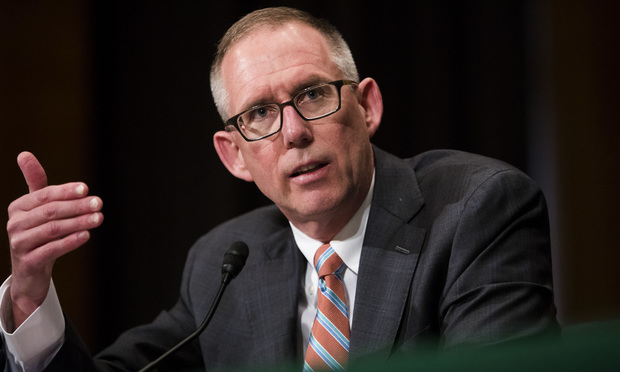 Morgan, Lewis & Bockiuspartner John Ring testifies at his confirmation hearing to be amember of the National Labor Relations Board on March 1.(Photo: Diego M. Radzinschi / NLJ)
Morgan, Lewis & Bockiuspartner John Ring testifies at his confirmation hearing to be amember of the National Labor Relations Board on March 1.(Photo: Diego M. Radzinschi / NLJ)
The Republican-led National Labor Relations Board is movingforward with a business-friendly proposal that would limit thescope of “joint employment” between companies,eliminating the liability one employer might have for unfair laborpractices at a franchise or contractor.
|The proposal to amend the agency's joint-employer standard wasexpected as Chairman John Ring, the former Morgan, Lewis &Bockius partner, announced his intent weeks ago to begin rulemakingon how to define relationships between companies,franchises, contractors and others. Companies found to be jointemployers can be jointly liable for labor violations committed bythe other.
|Related: NLRB rulings could proliferate in the comingmonths
|The Obama-era standard, long criticized by management-sidefirms, expanded the scope of joint employer. Business advocates andmanagement-side attorneys were hopeful Trump-appointed NLRB memberswould quickly overturn the Obama-era joint employer standard, setin a 2015 case called Browning-Ferris Industries.
|But the labor board got tripped up in anethical dispute when it tried to use a case toreverse the Obama ruling. Ethics officials said Trump-appointedboard member William Emanuel, a former Littler Mendelsonshareholder, should not have participated in ruling in thatcase.
|The new proposed rule would only allow a joint-employmentrelationship under circumstances of “substantial, direct andimmediate control over the essential terms and conditions ofemployment and has done so in a manner that is not limited androutine.” The board has opened a public comment period for 60 days.What follows is a snapshot of the process, and some of the issuesin play.
|Why a rule, and how long will this process take?
Rulemaking is rare at the NLRB. The labor board more often usescases to set compliance standards for industry and unions. Theethics conflict plaguing Emanuel—he denied any impropriety—pushedthe board into rulemaking, a process that could take months, if notyears, to complete. All interested sides will get a chance toparticipate in the process.
|“The way the rule is written, it will provide a lot more clarityto parties about the burden of proof, how much evidence to presentbefore someone is a joint employer,” said former NLRB member HarryJohnson, now a partner at Morgan Lewis. “The advantage ofrulemaking is they can delve much more into that.”
|Any new rule would apply prospectively, as opposed toretroactively, and provide greater certainty to regulatedparties.
|Democratic critics on Capitol Hill in the U.S. House ofRepresentatives and Senate contend the rulemaking process itself isinappropriate. They argue the NLRB is trying to sidestep the ethicsquestions raised by the earlier attempt to undo the Obamastandards.
|How is the regulatory proposal different from the Obama-erarule?
The proposed regulation says that to be deemed a joint employer,“an employer must possess and actually exercise substantial directand immediate control over the essential terms and conditions ofemployment of another employer's employees in a manner that is notlimited and routine.”
|In Browning-Ferris, the Democratic majority said thatthe board no longer would require proof that a joint employer hasexercised any “direct and immediate” control over the essentialworking conditions of another company's workers.
|Part of their Obama-era criticism over joint-employer—beyond theexpanded scope—centered on the contention the NLRB should have donemore to define the standards and give companies more concreteguidance.
|Under the proposed rule, indirect influence is no longer enoughto establish a joint-employer relationship. The proposal announcedlast week also presents specific examples that can serve as a guidefor companies.
|“The definition of employer is a fundamental concept thatunderlies the National Labor Relations Act. It's important that theboard lay out examples for comment that cover a reasonable expanseof different contexts,” said Philip Miscimarra, a former NLRBchairman who returned to Morgan Lewis inFebruary. “We made a comment in the dissent, that the[Browning-Ferris] decision did not serve the interest ofthe public.”
|What happens to ongoing cases?
A case working its way to the NLRB between Fight for $15 unionworkers and McDonald's Corp. is considered a test of the jointemployer issue. Because the rule would not apply retroactively,it's unclear what would happen in this case.
|Littler Mendelson and Morgan Lewis teams are working withMcDonald's.
|Another wrench in the joint-employer issue is thatBrowning-Ferris is still an active case in the U.S. Courtof Appeals for the D.C. Circuit. The appeals court has not issued aruling on the merits of the Obama-era joint employer standard.
|Ballard Spahr partner Steven Suflas said he expects a lot ofinaction on cases as the rulemaking process is ongoing. He saidthat he also expects the D.C. Circuit to delay issuing a rulinguntil after the process is complete. He said the board will likelysit on the joint-employer issues, as well, during the rulemakingprocess.
|Suflas said the board moves slowly. He said he has cases, eventhose that do not touch on such controversial issues as jointemployer, that have been sitting since as long as 2013.
|Read more:
Complete your profile to continue reading and get FREE access to BenefitsPRO, part of your ALM digital membership.
Your access to unlimited BenefitsPRO content isn’t changing.
Once you are an ALM digital member, you’ll receive:
- Critical BenefitsPRO information including cutting edge post-reform success strategies, access to educational webcasts and videos, resources from industry leaders, and informative Newsletters.
- Exclusive discounts on ALM, BenefitsPRO magazine and BenefitsPRO.com events
- Access to other award-winning ALM websites including ThinkAdvisor.com and Law.com
Already have an account? Sign In
© 2024 ALM Global, LLC, All Rights Reserved. Request academic re-use from www.copyright.com. All other uses, submit a request to [email protected]. For more information visit Asset & Logo Licensing.








